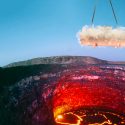Since its discovery in 1610 by Galileo, the rings of Saturn have enchanted us for centuries. Remarkably, we’ve visited Saturn before. Stunning photographs taken from the Cassini space probe have revealed that Saturn’s rings are much more complex than you might think. So what would it be like to actually go in person?
How long would it take you to travel to Saturn? What would you see along the way? Could you survive in Saturn’s rings?
On October 15th, 1997, NASA, the European Space Agency, and Italy’s ASI banded together to change the history of astronomy. Their mission was to study the Saturn system, a diverse mix of stellar objects made up of rocks, ice and several moons. Together they developed the space probe Cassini-Huygens, which was propelled on a seven year journey to Saturn. Let’s imagine we had the technology to bring you, traveller, along for the ride. What kind of adventure are you in for?
Well, luckily, we’re taking the scenic route. After a year of drifting through space and saying goodbye to Earth, our first stop is Venus. Don’t worry, this isn’t a layover, we’re merely visiting the outer edge of Venus’ orbit, giving you a gravitational speed boost as you pass by.
This will allow you to save on fuel and take in the view of Venus’ swirling scenery. After the first orbit, you’ll get a nice speed boost of 7 km/s (4 miles/s). But we’ll need one more journey around it for the optimal speed boost. This time, we’ll be about 600 km (370 miles) from Venus. I hope you have a strong stomach, traveller, as the gravitational pull might be like that time you ate funnel cake before going on that spinny ride at the fair! Oof, never again.
After a quick spin around Venus, you’ll be slingshotted towards Mars and Jupiter, but this part of the ride might get a little bumpy, so buckle up. You’re about to pass through an asteroid belt. Fortunately, the chances of hitting by an asteroid are pretty slim as they’re very spread apart, unlike what you might see in the movies. Still, you never know. Just be prepared to take manual control in case your proximity sensors malfunction.
Once you’ve made it through the scary part, it’s fairly smooth sailing from here on out. Sit back and admire the view. On your right, in the distance, you’ll see the red planet, Mars. And on your left, is Jupiter. Look! That shiny speck orbiting the gas giant is the Galileo spacecraft.
A small yet welcome reminder of home. At this point, it’s been almost five years. Wow, time flies when you’re being hurled through space! Saturn is our next stop. But is it safe? We’re about to find out.
After waiting a couple years, doing lots of Sudoku and rewatching all your favorite What If videos, we’ve finally arrived in orbit of Saturn. Surprisingly, the flat and solid ring structure you’ve seen in pictures back home were way off. These rings are complex systems of orbits, subdivided by several different sections.
On the outer rim, we have the D ring, followed by C, B, the Cassini Division, A, F, G, and lastly, the E ring. Each of these rings are separated by gaps made from over 60 of Saturn’s moons. The rings are made up of chunks of ice and rock, some as small as little boulders and some as big as houses. These are remnants of comets, asteroids, meteoroids and shattered moons torn apart by Saturn’s gravity.
Alright, traveller, it’s time for a spacewalk. You probably won’t have much success walking on Saturn’s rings, unless you happen to land on one of its moons, like Methone, Pallene, or even Titan, which has been considered a potential site for a future space colony.
But you’ll want to keep your space suit on, as Titan is a chilly -179.6 degrees Celsius (-292 F). At this point, you’re almost twice the distance between the Earth and the Sun. As you travel further in the rings, you’ll want to be extra careful. Even though there is quite a bit of space between the flying debris, collisions can still happen and you could be crushed like a bug if you’re not careful. If you happen to find a comfortable rock to land on and surf the rings, you might be lucky enough to see the moon Daphnis pass you by.
Now for the moment of truth. The Grand Finale. As we approach the final rings of Saturn, we’ll have to fly through them on a careful trajectory, orbiting Saturn 22 times to get our best travel shots. Here, you’d be only 2,000 km (1240 miles) away from Saturn’s atmosphere.
You might actually witness Saturn’s equinox, where the sun strikes the rings in such a way that from Earth, it looks as if they’ve disappeared. After about 20 years in space, you’d finally reach Saturn’s interior. Let’s be honest, you’d likely disintegrate.
But, thankfully, you were careful and managed to hang around on Titan instead, leaving the Cassini probe to do the rest of the work. Here is where you’d be spending your lonesome days sending data back to Earth. Hope you packed a lot of provisions, as the rescue mission might take a while.
The amount of data Cassini managed to send back to Earth is truly spellbinding, making it one of humankind’s greatest success stories in astronomy. Maybe on our next voyage, we could take a closer look at Saturn’s big brother, Jupiter. But not too close.
Subscribe to What-If on YouTube or follow the show on Facebook Watch.
Sources
- “The Vanishing Rings of Saturn”. 2020. science.nasa.gov.
- “In Depth | Saturn – NASA Solar System Exploration”. 2020. NASA Solar System Exploration.
- “How Many Rings Does Saturn Have? – Universe Today”. FRASER CAIN, 2009. Universe Today.
- “Cassini Overview”. 2020. NASA.
- “Overview | The Grand Finale – NASA Solar System Exploration”. 2020. NASA Solar System Exploration.
- “Timeline | The Journey – NASA Solar System Exploration”. 2020. NASA Solar System Exploration.
- “The Astrophysics Spectator: Saturn’s Rings”. Wilkinson, Freddie. 2020. astrophysicsspectator.com.

















